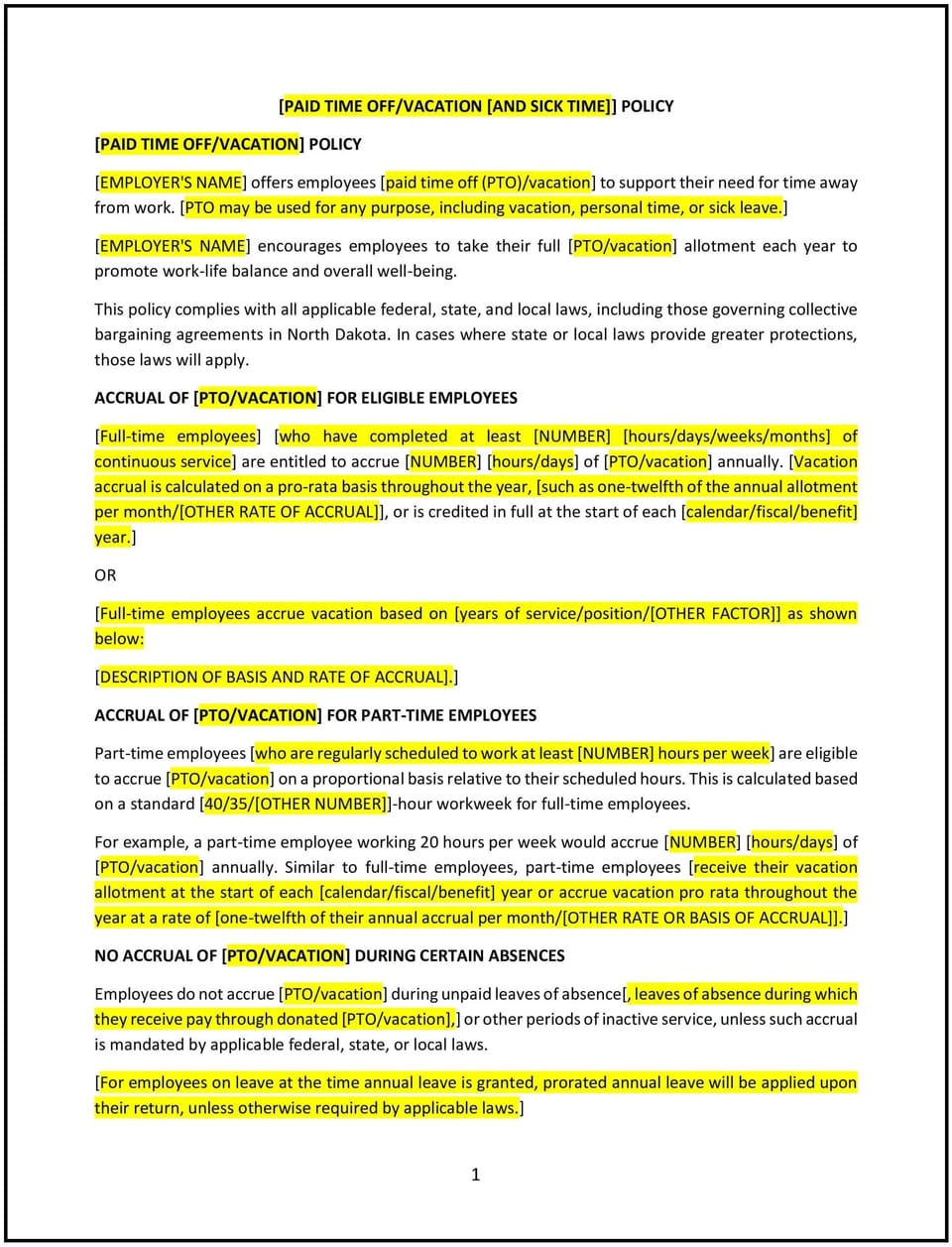Vacation policy (North Dakota): Free template

Vacation policy (North Dakota)
This vacation policy is designed to help North Dakota businesses establish guidelines for employee vacation leave. It outlines procedures for requesting leave, accrual rates, and job protection during vacation.
By adopting this policy, businesses can support work-life balance, enhance employee satisfaction, and maintain productivity.
How to use this vacation policy (North Dakota)
- Define vacation leave: Clearly explain what constitutes vacation leave and its purpose, such as rest and relaxation.
- Establish accrual rates: Specify how vacation time is accrued, such as hours worked or years of service.
- Set request procedures: Provide steps for employees to request vacation leave, including required notice and approvals.
- Address carryover: Specify whether unused vacation time can be carried over to the next year or forfeited.
- Ensure job protection: Guarantee that employees will return to the same or an equivalent position after vacation.
- Train managers: Educate supervisors on handling vacation requests and maintaining workflow during employee absences.
- Review and update: Assess the policy annually to strengthen alignment with evolving business needs and employee expectations.
Benefits of using this vacation policy (North Dakota)
This policy offers several advantages for North Dakota businesses:
- Supports work-life balance: Demonstrates a commitment to helping employees recharge and maintain well-being.
- Enhances employee satisfaction: Provides employees with paid time off, boosting morale and retention.
- Aligns with best practices: Offers a structured approach to managing vacation leave.
- Reduces burnout: Encourages employees to take time off, improving productivity and reducing turnover.
- Builds trust: Shows employees that the business values their personal time and contributions.
Tips for using this vacation policy (North Dakota)
- Communicate clearly: Ensure all employees understand the policy and their eligibility for vacation leave.
- Provide training: Educate managers on handling vacation requests and maintaining workflow during employee absences.
- Monitor usage: Track vacation requests to ensure consistency and identify trends.
- Encourage transparency: Foster a culture where employees feel comfortable requesting vacation leave without fear of retaliation.
- Update regularly: Review the policy annually to strengthen alignment with evolving business needs and employee expectations.
Q: How does this policy benefit businesses?
A: It supports work-life balance, enhances employee satisfaction, and reduces burnout by providing vacation leave.
Q: How is vacation time accrued?
A: Vacation time is typically accrued based on hours worked or years of service, with rates increasing over time.
Q: Can unused vacation time be carried over?
A: This depends on the business’s policy. Some businesses allow carryover, while others require employees to use vacation time within the year.
Q: What should businesses do if an employee’s vacation request conflicts with business needs?
A: Businesses should work with the employee to find a mutually agreeable solution or reschedule the vacation if possible.
Q: How often should businesses review this policy?
A: Businesses should review the policy annually or as needed to strengthen alignment with evolving business needs and employee expectations.
This article contains general legal information and does not contain legal advice. Cobrief is not a law firm or a substitute for an attorney or law firm. The law is complex and changes often. For legal advice, please ask a lawyer.


